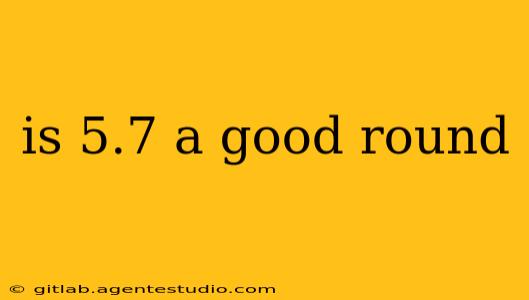Is 5.7 a Good Round? Understanding Rounding in Different Contexts
The question "Is 5.7 a good round?" doesn't have a simple yes or no answer. Whether 5.7 is considered "good" depends entirely on the context – the specific application and the desired level of precision. Let's explore different scenarios:
1. Rounding to the Nearest Whole Number:
In this common scenario, we look at the digit after the decimal point. If it's 5 or greater, we round up; if it's less than 5, we round down. Therefore, 5.7 rounds up to 6. In this context, rounding 5.7 to 6 is considered a perfectly acceptable and accurate rounding procedure.
2. Rounding to One Decimal Place:
Here, we examine the second digit after the decimal. Since there's only one digit (7) after the decimal point in 5.7, it remains 5.7. No rounding is necessary.
3. Rounding in Specific Applications:
The appropriateness of rounding 5.7 also depends heavily on the specific field. Consider these examples:
-
Finance: Rounding to the nearest cent is crucial. 5.7 dollars would remain 5.7 dollars unless a specific rounding rule (e.g., always rounding up for financial transactions) is in place. Rounding in finance often needs to adhere to strict regulations to ensure accuracy and prevent discrepancies.
-
Measurement: If 5.7 represents a measurement (e.g., 5.7 meters, 5.7 liters), rounding may be appropriate depending on the measuring instrument's precision and the needed accuracy. In some contexts, 6 might be close enough; in others, maintaining 5.7 might be essential.
-
Statistics: In statistical analysis, rounding can significantly affect calculations. The level of rounding is determined by the specific statistical method used and the desired level of significance. Simply rounding to the nearest whole number might introduce unacceptable errors.
-
Scientific Calculations: In scientific applications, rounding rules are usually explicitly defined. The number of significant figures determines the appropriate level of rounding to maintain accuracy. Premature rounding can lead to significant error propagation.
4. "Good" in the Sense of Round Numbers:
Sometimes, "round" refers to numbers that are easy to work with mentally – typically multiples of 5 or 10. While 5.7 is close to 6 and arguably "near" a round number, it's not as immediately convenient as a whole number like 5 or 10.
Conclusion:
Whether 5.7 is considered a "good" round number depends entirely on the context. There's no universal answer. The appropriateness of rounding depends on the desired level of precision and the potential impact of rounding errors on the application or calculation. Always consider the specific requirements of your situation before rounding.

